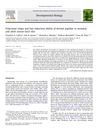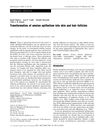Expansion of Specialized Epidermis Induced by Hormonal State and Mechanical Strain
May 2015
in “
PMC
”
TLDR Nipple area expansion in mice needs both pregnancy hormones and mechanical strain.
The study investigated the expansion of specialized epidermis in mice, particularly focusing on the nipple area, which undergoes significant changes with reproductive status. Researchers observed that areola formation involved increased thymidine analog uptake in the epidermis and hair follicles, without changes in connective tissue cell proliferation but with altered extracellular matrix gene expression. Fibroblasts in the nipple area showed higher levels of estrogen, progesterone, relaxin, and oxytocin compared to ventral skin. The study used models to separate the effects of pregnancy, lactation hormones, and mechanical strain, finding that areola formation required both pregnancy hormones and mechanical strain, with individual stimuli only causing modest changes.



